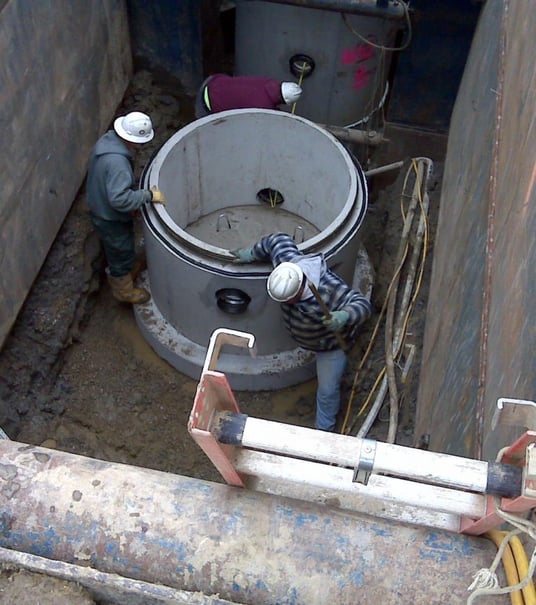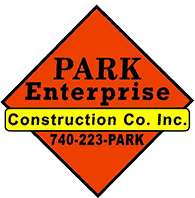
Underground utility construction can be a complicated process in any scenario. Like any other type of construction, the goal is to create a functional finished product while making it look like workers were never even there. But in reality, the means to get to that end is a highly invasive experience that quite literally alters the landscape.
Underground utilities, however, don’t have the luxury of a polished final appearance as a beautiful new building would, for instance. But their functions are vital importance to the daily operations of businesses, organizations, and other commercial property developments.
The following is an underground utilities quality assurance checklist to guide the installation of water lines, storm sewers, and sanitary sewers.
- General Quality
- Storm Sewer
- Sanitary Sewer
- Waterlines
Underground Utility Construction Quality Assurance Review
General Quality Checklist
☐ Is the overall installation of the proposed utility functioning properly?
Simply enough (and most importantly), does it work? Testing and retesting under pressure is often necessary to ensure the proper functioning of an underground pipe.
☐ Have all settling areas been backfilled?
Most of the time, dirt where trenches were dug to install lines will settle and must be backfilled again. This usually occurs in green areas where compaction is not required. Detail your landscaping requirements to your contractor to ensure the affected portion of your property is both safe and visually appealing after the work is complete.
☐ Have all unwanted and unused dirt piles been removed?
Almost certainly, there will be unused dirt left over after utility trenches are dug and filled back in. Discuss a plan with your underground utility contractor for its safe and legal disposal.
☐ Have the as-builts been completed and turned over to the owner?
These are “marked up” copies of the plans that note things construction crews encountered, changed, or modified in the field as the utility was being installed. These could include other underground utility lines, previous foundations, rock formations, natural gas pockets, mineral deposits, and other sometimes unforeseen physical obstacles.
☐ Has the location of the completed utility been referenced with GPS and the coordinates documented?
Utility markers can get covered up or buried over time. It’s important to be able to find the underground line and other features when maintenance may be necessary. GPS coordinates will assist in this. As always, make sure your contractor calls OUPS (the Ohio Utilities Protection Service) before digging.
☐ Have all landscaping restoration efforts been completed?
Underground utility installation often makes a mess and sometimes even damages existing facilities. A quality job is not complete without making every effort possible to restore the property to its original appearance.
☐ Has the site been cleaned up including all trash and mud on the streets or buildings?
This is housekeeping common sense. At the project’s conclusion, it’s the law to wash dirt- and mud-covered buildings and adjacent roadways. The process sometimes also produces refuse that must be disposed of appropriately and legally.
☐ Has all equipment been removed from the site?
Every last excavator, bulldozer, jackhammer, monkey wrench, and bolt must be removed from your site by a set time and date.
☐ Have all other excess materials been removed from the site?
In addition to equipment and tools, underground utility installation involves building materials including various sizes and types of piping, bolts, nuts, concrete, construction aggregate, and more. Any leftover material should be removed to be recycled or disposed of properly and legally.
☐ Are all utility access points clear and accessible?
All catch basins, manholes, shut-off valves, and other interventional points along the utility line should be accessible from grade (ground level). They must not be buried and should be clearly marked for future reference.
☐ Have all trench compaction tests been completed and signed off by the inspector?
Compaction is the process by which loose dirt, stones, and construction aggregate settle after being placed, backfilled, and pressed down. The strength of these refilled trenches may not be as important in green areas, but it’s critical for areas that’ll carry traffic. Failure to ensure proper compaction will likely mean ultimate failure of the driving surface (like these examples).
☐ Have all service locations for future hookups been marked with wye (marking) poles?
Wye poles are usually 4’x4” posts used to mark the location of the service connection point for future reference.
☐ Have all existing utilities been preserved with no damage caused by your contractor? If your contractor is installing underground utility line of one kind, chances are they’ll encounter other active and inactive pipes that serve or served different purposes. Work must happen around those lines while causing absolutely no damage and minimal service interruption, if necessary. Again, your contractor should call OUPS before digging and inspect afterward.
☐ Have you and your contractor walked the site and developed a punch list?
A punch list is an inventory of final tasks to be completed for an underground utility project to be considered officially finished. Your contractor should walk over the site with you for a detailed visual explanation. You or your contractor may discover minor jobs left undone.
Storm Sewer Quality Assurance Checklist
☐ Are the catch basins and manholes clean and free of debris?
This is an ongoing cleanliness and maintenance effort to keep the new pipe from plugging with foreign debris.
☐ Has all inlet protection been installed?
These are bags that go over the catch basins to prevent ground sediment, particles, and other debris from infiltrating new pipes. In appropriate places that have high amounts of sediment, these can be effective at filtering total dissolved solids such as sand, silt, and clay that could build up over time and clog the system.
☐ Have all inverts been poured?
An invert is the base level of a pipe, tunnel, or trench poured in the bottom of catch basins to allow a better flow of water. Water flows with gravity from the inside the catch basin to the storm sewer system. These inverts must be checked and documented on the as-builts (explained above).
☐ Have the castings been checked after paving and final grade verified to ensure no movement has taken place?
Castings are the grates or covers over a storm sewer catch basin. As other construction takes place around them, like asphalt paving, they can sometimes move out of place. Checking these castings ensures no movement or damage has occurred to allow sediment in the system.
☐ Have mandrels been pulled, passed, and signed off by the owner or a representative?
A mandrel (or deflection gauge) is a test to ensure the roundness of the new pipe to verify it’s not egg shaped. A misshapen pipe may present issues with free water flow and could become more deformed over time.
☐ Is all backfill complete and compacted?
Trenches and holes dug to accommodate storm sewer systems must be backfilled and compacted to support the pipe below and the grade above. Proper compaction is critical when the grade will support a heavy driving surface.
☐ Are all inverts within 0.1 ft of plan grade?
One-tenth of a foot is usually the maximum tolerance accepted for an invert grade. The correct grade helps the storm sewer transfer water downhill.
☐ Are all castings and inlets on grade?
Castings and inlets that aren’t even with the terrain or driving surface around them are an accident waiting to happen. They must not stick up too high or sit are too low, for their own effective functioning and for driving surfaces around them. These must also be on grade for a clean, uniform appearance.
☐ Are all catch basins and manholes mortared to protect against unwanted infiltration?
All castings and pipe must be mortared so all holes are sealed to prevent dirt (and even unwanted water) from getting in. Excess groundwater infiltration through holes and cracks in the storm sewer can inundate the system, especially during the spring thaw or periods of heavy rain.
☐ Has all pipe coming through the structure been cut off flush with the inside walls?
This makes for a cleaner appearance and appropriate functioning. A pipe that is not flush with the structure of the storm sewer catch basin would likely allow debris to accumulate around it and clog the system later.
Sanitary Sewer Quality Assurance Checklist
☐ Have all air tests been completed, passed, and signed off by the owner or a representative?
A sanitary sewer that is airtight is watertight. This test involves pumping a mass of air into the pipe. It usually must hold 5 pounds of pressure per square inch (PSI) for 10 minutes. Leakage can be measured by the amount of air it takes to maintain the pressure.
☐ Have all mandrel tests been completed, passed, and signed off by the owner or a representative?
This test (explained above) uses a deflection gauge to ensure the roundness of the new pipe and verify it is not misshapen. Non-concentric pipe (pipe that’s out of round) may present issues with free water flow and could experience more deformation over time.
☐ Have all vacuum tests been completed, passed, and signed off by the owner or a representative?
This is a test on manholes to verify they’re watertight. A vacuum is created after air is sucked from the manhole structure. Atmospheric pressure on the outside of the manhole (about 15 PSI) will create a pressure differential within the internal structure of about 5 PSI. Any air leakage, which would equate to a water leakage, can be measured by how much extra vacuum must be created to maintain that differential.
☐ Are Chimney Seals installed if necessary?
These are rubber rings placed on the inside of the manhole casting to help fight against water infiltration around the top. Excess water and dirt infiltration can overwhelm the system.
☐ Is all backfill complete and compacted?
Trenches and holes dug to accommodate sanitary sewer systems must be backfilled and compacted to support the pipe below and the grade above.
☐ Are all inverts within .1 ft of plan grade?
One-tenth of a foot is usually the maximum tolerance allowed for an invert grade. Poor grading could lead to a failure or backup in gravity-assisted flow.
☐ Have all inverts been checked and documented on the as-builts?
Once built, the inverts must be checked for grading and effective operation. These must be documented in the as-builts (described above) to the property owner or a representative.
☐ Are all castings on grade?
Manholes and other castings must be on grade, or even, with the terrain or driving surface around them. They must not stick up too high or sit are too low, for their own effective functioning and for driving surfaces around them. This also creates a clean, uniform appearance.
☐ Are all laterals marked with wye (marking) pole?
Above-ground marking allows future identification and maintenance of any type of line. An appropriate marking will not only identify the location of access points along the line, but also the type of line for safety purposes.
☐ Have the castings been checked after paving and final grade to ensure no movement has taken place?
Castings and other markers can be moved or damaged as other construction, like asphalt paving, occur around them. Damage or movement could slow, block, or break the sanitary sewer system.
☐ Are the manholes clean and free of debris?
This is a routine maintenance/cleaning issue and a good practice to ensure quick and easy access to your underground utilities.
Waterlines Quality Assurance Checklist
☐ Have all hydrostatic tests been completed, passed, and signed off by the owner or a representative?
This is a test to make sure the waterline has no leaks. Lines are typically tested at 150 PSI for 2 hours. Fire lines, which must withstand much more pressure, are tested at 200 PSI.
☐ Have all “pigs” been pulled for lines 12” and larger?
A “pig” is a ball the size of the pipe pushed through with water pressure. This is required on large diameter lines to make sure nothing is stuck in the pipe.
☐ Have all service lines been marked with wye pole?
Above-ground marking and access to any underground utility is crucial for its future identification and maintenance. An appropriate marking will not only identify the location of access points along the line, but also the type of line for safety.
☐ Are all house service and valve boxes adjusted to grade?
These are the access points for the in-line shut offs. These valves must allow easy access in an emergency. If there’s a leak or other malfunction in the system that must be fixed, that section of line must be closed to permit immediate maintenance.
☐ Are all curb stops centered and easily accessible in the boxes?
The box identifies the exact location of the water line and keeps the valve clean. Since the valve is usually at least 4 ft underground, these must be straight so the “key” can be used to shut it off.
☐ Has the continuity of the tracer wire been checked and passed?
This is also called locating or locator wire, and it’s used to find pipes and other lines after they've been buried. This wire must also be accessible at grade at the valve and curb boxes.
☐ Has the bac-t test been completed, passed, and signed off by the owner or a representative?
A domestic and/or public waterline is useless (and dangerous) if it’s not safe for human consumption. This test ensure there is no bacteria in the water line. It’s taken in 2 parts, 24 hours apart, to avoid false positives or negatives.
☐ Are hydrants turned the proper direction?
A fire hydrant nozzle facing the wrong direction could cost valuable time in an emergency. Local fire departments have regulations dictating the proper locations needed to provide their life- and property-saving services.
☐ Have fire lines been flow tested?
This test ensures fire lines have the proper pressure needed to service the sometimes thousands of gallons of water needed to fight a fire.
☐ Have all lines been flushed?
This is necessary so any dirt, rocks, or any other foreign material gets flushed out before the line is put in service. Such debris can clog lines and affect water quality for your property and others in the system.
☐ Is all backfilling complete and compacted?
Trenches and holes dug to accommodate water lines must be backfilled and compacted to support the pipe below and the grade above.



